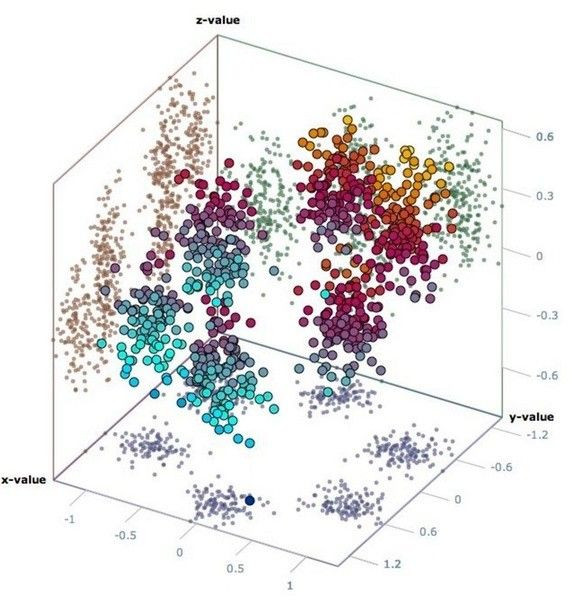Gender-Fluid: Are Human Sexuality And Gender Identity A Spectrum From Male To Female, Or Binary?


This question originally appeared on Quora. Answer by Jae Alexis Lee, Trans Woman.
There’s been a great deal of conversation lately about understanding gender as a spectrum. Typically, we’d present that with a visual like this:

The idea is that you have female at one end of the spectrum, male at the other, and while most people group at the ends, there are many people who fall all along the spectrum between. But is this the best way to view gender? Does this really explain it?
Researchers have been exploring human sexuality and gender for decades and in that time we’ve seen several different models proposed. I recently ran across one model that suggested you could envision trans people on a spectrum based on sexuality: Gay -> Gay and Gender Dysphoric (really gay), -> Transsexual (super, super gay.) Okay, I’m poking a little fun, the actual text was Homosexual -> Gender Dysphoric Homosexual -> Transsexual but you get the point.
Funky stuff right? I about choked when I read it in a literature review from a psychobiologist that I tend to respect but I also won’t deny that it’s a way to visualize the observed data. A proposed step towards a “grand unification of sexuality and gender” if you will.
The problem, fundamentally, is that neither gender or sexuality can be put into neatly demarcated boxes. Things aren’t black and white and there are lots of shades of gray. It’s that realization that gets us to thinking of both gender and sexuality as spectra. We put straight on one end and gay on the other and try to describe everything as somewhere in between. We put male on one end and female on the other and try to describe everything as somewhere in between.
Does that work as a model? Sort of. About as well as anything else does. Models for understanding complex phenomenon also fall on a spectrum with highly accurate at one end and easily understandable at the other. More easily understood models tend to be less accurate and won’t fit “edge cases” where highly accurate models that encompass more data points aren’t as easy to visualize and understand.
Let’s say, for example, that we have a 3 axis model for understanding sexuality and gender.
Axis One: Attracted to men <-> Attracted to women
Axis Two: Identifies as male <-> identifies as female
Axis Three: Experiences gender strongly <-> Does not experience gender strongly
(yeah, I know, this really should have a fourth axis for strength of experiencing sexual attraction and even then it’s incomplete…. just hang with me while I make a point.)
So, you take this model, sample the population and come up with a map of gender and sexuality that looks like… I dunno, this:

So… where in the cloud do I fall?
We can take data and from that data produce a model that predicts the population. We can then re-sample the population and see if the population fits the model as expected. If it does, the model gains credibility, if it doesn’t we adjust the model and repeat.
Gender as a spectrum is a model for understanding gender. It’s a very simple model that presents gender on a single continuum between two poles. For a large percentage of the population, the model works, but, clearly there is a non-zero percentage of the population for whom the model doesn’t work.
Gender as a spectrum is an easily understood model of gender but as we discussed above, easily understood isn’t the same as highly accurate. There is nothing wrong with using easily understood models. It’s difficult to jump from zero knowledge in a subject to complex and highly accurate models. It also isn’t necessarily useful for people to acquire highly accurate models for everything they need to understand at some level.
The problem occurs when the easily understood model is seen as a highly accurate model (which it isn’t.) The problem gets worse when we try to invalidate data points (who are, let’s not forget, real people) that don’t fit the easily understood model. It gets a lot worse when the invalidation of things that don’t fit the easily understood model is used to make policy or support bigotry against things that don’t fit the model.
We’re going to be trying to build an accurate model for gender and sexuality for a long while. We’ve been trying for decades and our models are better but I have yet to see anything I’d see that represents a grand unified model of gender or sexuality (or both.) It’s okay if most people don’t understand more complex models of gender and sexuality as long as they understand that there are things that don’t fit within the easily understood model and that the model very expressly doesn’t describe everything there is to know.
We have a problem right now with people clinging to simplified models. To the notion that XX = Female and XY= Male and nothing else exists. The notion that people are either 100 Percent Straight or 100 Percent Gay or half way between the two. People find the notion that a person’s romantic attraction is independent of their sexual attraction ludicrous or at least difficult to comprehend. The problem is that people believe simplified and easily understood models represent the whole of human experience. That’s the problem we need to correct. We don’t need to toss out easily understood models because those models useful for teaching concepts at introductory levels. We just need to do a better job at getting people to understand that the model isn’t an end point.
More from Quora:



























